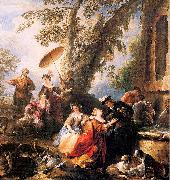All Parrocel, Joseph's oil paintings


|
|
|
| ID |
Image |
Oil Pantings, Sorted from A to Z |
Other Information |
| 19765 |
 |
Cavalry Battle |
Oil on canvas
Galleria degli Uffizi, Florence. |
| 30046 |
 |
Cavalry Battle |
mk67
Oil on canvas
19 11/16x26 3/8in
Uffiz,Gallery
|
| 20651 |
 |
Crossing of the Rhine by the Army of Louis XIV on 12 June (mk05) |
1672
Canvas 92 1/4 x 64 1/2''(234 x 164 cm)Painted for the Chateau de Marly in 1699;collection of Louis XIV |
| 51020 |
 |
The Crossing of the Rhine by the Army of Louis XIV |
1672 1699
Oil on canvas,
234 x 164 cm |
| 19766 |
 |
The Return from the Hunt |
1700
Oil on canvas
National Gallery, London. |
| 43235 |
 |
The Return from the Hunt |
mk170
circa 1700
Oil on canvas
110.5x106cm
|
|
|
| Parrocel, Joseph
|
| French, 1646-1704
He studied with his father Barthelemy Parrocel (1595-1660) and then with his elder brother Louis Parrocel (1634-94). He went to Paris for four years to perfect his work and then, c. 1667, to Rome, where he became the pupil of the battle painter Jacques Courtois and was influenced by Salvator Rosa. He remained in Italy for eight years and stayed for a time in Venice, before returning to settle in Paris in 1675. He was approved (agree) by the Academie Royale de Peinture et de Sculpture in February 1676 and received as a full member in November of the same year, presenting the Siege of Maastricht (Draguignan, Mus. Mun.). His painted oeuvre consists principally of military scenes, particularly battles, and he received numerous royal commissions. In the period 1685-8 he executed 11 paintings for the Salle du Grand Couvert at the cheteau of Versailles (nine in situ; one in Tours, Mus. B.-A.; one in Dijon, Mus. B.-A.); in 1699 he painted the Crossing of the Rhine (Paris, Louvre.) for the cheteau of Marly, Yvelines, and in 1700 he executed the Fair at Bezons (Tours, Mus. B.-A.), anticipating the fetes galantes of Antoine Watteau. He was also the author of a number of hunting scenes . His most important religious paintings were the May of Notre-Dame de Paris of 1694, St John the Baptist Preaching (Arras, Mus. B.-A.) and St Augustin Succouring the Sick (c. 1703; Nantes, Mus. B.-A.), which was intended for the monastery in the Place des Victoires in Paris. He also contributed battle scenes to the backgrounds of portraits by Hyacinthe Rigaud and by Gabriel Blanchard. His technique was highly original in the context of his time; he employed a very free style of execution and used thick impasto and intense colours. He was also a prolific engraver, producing around 100 plates,
. Related Artists to : | Wilhelm Trubner | Vleughels Nicolas | jeremy collier | alexej von jawlenskij | George Frederick watts,O.M.,R.A. | |

|
|

|
|